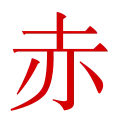赤
See also: 亦
 | ||||||||
| ||||||||
| ||||||||
Translingual
| Stroke order | |||
|---|---|---|---|
 | |||
Han character
赤 (Kangxi radical 155, 赤+0, 7 strokes, cangjie input 土中弓金 (GLNC), four-corner 40331, composition ⿱土⿻小丿(GTJKV) or ⿱土⿻小丨(H))
- Kangxi radical #155, ⾚.
Derived characters
References
- KangXi: page 1213, character 22
- Dai Kanwa Jiten: character 36993
- Dae Jaweon: page 1680, character 12
- Hanyu Da Zidian (first edition): volume 5, page 3506, character 1
- Unihan data for U+8D64
Chinese
Glyph origin
| Historical forms of the character 赤 | |||||||
|---|---|---|---|---|---|---|---|
| Shang | Western Zhou | Spring and Autumn | Warring States | Shuowen Jiezi (compiled in Han) | Liushutong (compiled in Ming) | ||
| Oracle bone script | Bronze inscriptions | Bronze inscriptions | Chu slip and silk script | Qin slip script | Ancient script | Small seal script | Transcribed ancient scripts |
 |
 |
 |
 |
 |
 |
 |
 |
Characters in the same phonetic series (赤) (Zhengzhang, 2003)
Ideogrammic compound (會意) : 大 (“person, big”) + 火 (“fire”) – the color of fire (a person by a fire).
Etymology 1
| simp. and trad. |
赤 | |
|---|---|---|
| alternative forms | 灻 𤆍 烾 ancient | |
Perhaps from Proto-Sino-Tibetan *krak (“blood; red”), whence Tibetan ཁྲག (khrag, “blood”) (STEDT; Schuessler, 2007). Related to 赫 (OC *qʰraːɡ, “bright red”) and possibly 奭 (OC *hjaɡ, “majestic; red”).
Pronunciation
Definitions
赤
- (literary or poetic) red
- 莫赤匪狐,莫黑匪烏。 [Pre-Classical Chinese, trad.]
- From: The Classic of Poetry, c. 11th – 7th centuries BCE, translated based on James Legge's version
- Mò chì fěi hú, mò hēi fěi wū. [Pinyin]
- Nothing red is seen but foxes,
Nothing black but crows.
莫赤匪狐,莫黑匪乌。 [Pre-Classical Chinese, simp.]
- (Teochew) brown
- loyal; sincere
- 赤忱 ― chìchén ― absolutely sincere
- empty; bare
- to be naked
- (politics) revolutionary; communist; red
- 赤化 ― chìhuà ― to communize; to turn Red
- pure gold
Synonyms
- (red):
Dialectal synonyms of 紅 (“red”) [map]
Compounds
Derived terms from 赤
|
|
|
Descendants
- → Proto-Mien: *sekᴰ (“red”)
Etymology 2
| simp. and trad. |
赤 | |
|---|---|---|
| alternative forms | 𣤩 | |
(This etymology is missing or incomplete. Please add to it, or discuss it at the Etymology scriptorium. Particularly: “From 刺?”)
Pronunciation
Definitions
赤
Synonyms
Dialectal synonyms of 疼 (“painful”) [map]
Japanese
| Stroke order | |||
|---|---|---|---|
Readings
Compounds
Compounds
- 赤子 (akago)
- 赤字 (akaji)
- 赤ちゃん (akachan)
- 赤土 (akatsuchi), 赭土 (akatsuchi)
- 赤面 (akatsura), 赭面 (akatsura)
- 赤の他人 (aka no tanin)
- 赤恥 (akahaji)
- 赤羽太 (akahata)
- 赤裸 (akahadaka)
- 赤まんま (akamanma)
- 赤身 (akami)
- 赤銅 (shakudō)
- 赤熱 (shakunetsu)
- 赤烏 (sekiu)
- 赤外 (sekigai): infrared
- 赤子 (sekishi)
- 赤日 (sekijitsu)
- 赤手 (sekishu)
- 赤十字 (Sekijūji): the Red Cross
- 赤心 (sekishin)
- 赤誠 (sekisei): sincerity
- 赤沈 (sekichin)
- 赤鉄鉱 (sekitekkō)
- 赤土 (sekido)
- 赤道 (sekidō)
- 赤熱 (sekinetsu)
- 赤飯 (sekihan)
- 赤貧 (sekihin)
- 赤面 (sekimen)
- 赤裸 (sekira)
- 赤痢 (sekiri)
- 赤燐 (sekirin)
- 赤化 (sekka), 赤化 (sekika)
- 赤禍 (sekka), 赤禍 (sekika)
- 赤血球 (sekkekkyū)
- 赤信号 (akashingō): red light
Pronunciation
Derived terms
See also
| 白 (shiro) | 灰色 (haiiro), 鼠色 (nezumiiro) (dated) |
黒 (kuro) |
| 赤 (aka); 深紅 (shinku), クリムゾン (kurimuzon), 紅色 (beniiro), 紅色 (kurenaiiro), 茜色 (akaneiro) |
オレンジ (orenji), 橙色 (daidaiiro); 茶色 (chairo), 褐色 (kasshoku) |
黄色 (kiiro); クリーム色 (kurīmuiro) |
| 黄緑 (kimidori) | 緑 (midori), 青 (ao) (dated) |
若緑 (wakamidori) |
| シアン (shian); 鴨の羽色 (kamo no hane iro) | 水色 (mizuiro) | 青 (ao) |
| 菫色 (sumireiro); 藍色 (aiiro), インジゴ (injigo) |
マゼンタ (mazenta); 紫 (murasaki) | ピンク (pinku), 桃色 (momoiro) |
Kunigami
Pronunciation
- IPA(key): /hakaː/
Miyako
Pronunciation
- IPA(key): /aka/
Northern Amami-Oshima
Pronunciation
- IPA(key): /axa/
Okinawan
Pronunciation
- IPA(key): /ʔaka/
Yaeyama
Pronunciation
- IPA(key): /ʔaka/
Yonaguni
Pronunciation
- IPA(key): /aɡa/
This article is issued from Wiktionary. The text is licensed under Creative Commons - Attribution - Sharealike. Additional terms may apply for the media files.